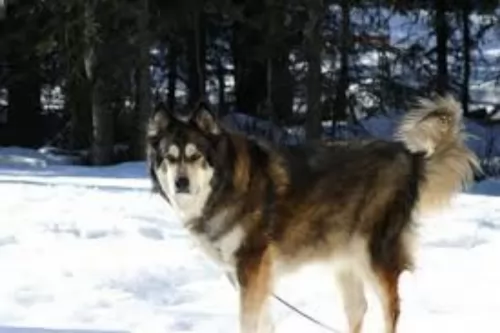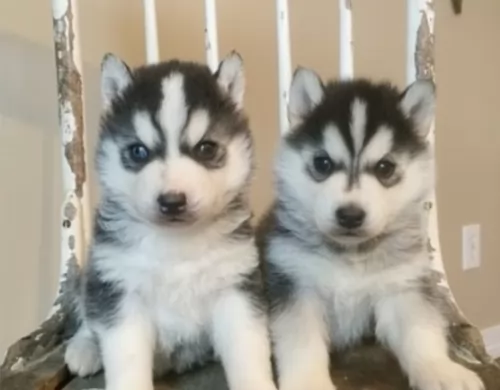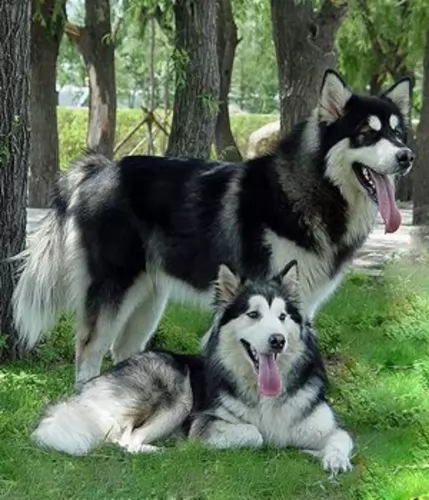 MyDogBreeds
MyDogBreeds Mackenzie River Husky is originated from United States but Havanese is originated from Cuba. Mackenzie River Husky may grow 47 cm / 19 inches higher than Havanese. Mackenzie River Husky may weigh 41 kg / 91 pounds more than Havanese. Both Mackenzie River Husky and Havanese has almost same life span. Both Mackenzie River Husky and Havanese has almost same litter size. Mackenzie River Husky requires Moderate maintenance. But Havanese requires High maintenance
Mackenzie River Husky is originated from United States but Havanese is originated from Cuba. Mackenzie River Husky may grow 47 cm / 19 inches higher than Havanese. Mackenzie River Husky may weigh 41 kg / 91 pounds more than Havanese. Both Mackenzie River Husky and Havanese has almost same life span. Both Mackenzie River Husky and Havanese has almost same litter size. Mackenzie River Husky requires Moderate maintenance. But Havanese requires High maintenance
 The name Mackenzie River Husky was given to these huskies by those wanting to name the freight huskies of a certain area. The name took hold in the 1960’s, but the dog began to disappear with the introduction of snow machines.
The name Mackenzie River Husky was given to these huskies by those wanting to name the freight huskies of a certain area. The name took hold in the 1960’s, but the dog began to disappear with the introduction of snow machines.
They’re a mixture of native sled dogs - Newfoundlands, St. Bernards, Staghounds and Wolf. As a mixed breed, they have always been regarded as classic sled dogs.
 The only breed of dog that is native to Cuba is the Havanese. These little dogs are great companion animals. Sociable and happy, they are very popular in the United States with urbanites. These happy little pups are a Bichon type of dog which was developed from the “Little White Dog of Havana” or the Blanquito de la Habana which is now extinct.
The only breed of dog that is native to Cuba is the Havanese. These little dogs are great companion animals. Sociable and happy, they are very popular in the United States with urbanites. These happy little pups are a Bichon type of dog which was developed from the “Little White Dog of Havana” or the Blanquito de la Habana which is now extinct.
The Blanquito de la Habana was itself developed from another extinct breed the Bichon Tenerife. Then the Blanquito was bred with the other Bichons and poodles in developing the Havanese. It is believed that some of the first people to settle in Cuba were from Tenerife, an island close to Cuba. In the early part of the sixteenth century, little white dogs were brought to Cuba with these settlers. This dog of Tenerife is believed to be the ancestor of all Bichon breeds.
At that time trade with Cuba was highly restricted by the Spanish and so these dogs developed without any crossing from other breeds from outside the country. They grew to be able to stand hot temperatures and they grew a very unique coat – almost like silk. Their coat is soft and light, while insulating them from the tropical environment.
At this time Cuba was the place to be for Europeans aristocrats on vacation. Unlike the British colonies, Cuba had theatres, operas and palacious. When going back to Europe, many took this little white dog with them to France, Spain and England. The Dog of Havannah was a favorite on European soil as well. Many of these dogs taken to Europe were fawn or parti instead of white. Meanwhile back in Cuba, the bourgeoisie were replacing the aristocracy who themselves would soon be replaced by the Revolution.
During the days of the bourgeoisie, the Havanese became very popular household pets. The breed has been a family pet for the last 150 years. At the same time the breed was very trendy in Europe with Charles Dickens and Queen Victoria owning several. They were by now familiar participants in Europe’s dog shows. Finally, with the Revolution, the bourgeoisie left the country in droves with their little white dogs. A genetic pool was then formed in the US. Gene pool from 11 dogs. All the Havanese in the world are descended from those 11 dogs with the exception of the dogs isolated in Cuba and the US. Today the Havanese is one of the most popular and fastest growing breeds in the world.
 The beautiful Mackenzie River Husky stands at 66 to 74cm in height and weighs between 29 and 47kg.
The beautiful Mackenzie River Husky stands at 66 to 74cm in height and weighs between 29 and 47kg.
This deep chested dog has a long, straight coat with the colors being typically wolf-like – white, cream, black, tan, blonde and red. He has erect ears, long legs and a long, bushy tail.
This wolf-type dog is strong willed and independent and was always a pack dog. They wouldn’t be described as a good choice for the first time dog owner as they do seem to have some wolf traits and will require a strong, firm, level headed owner.
 The Havanese is a sturdy little dog, a member of the toy group. They weigh no more than 16 pounds (7.3kg) and his body is longer than it is tall. The breed has a unique topline that is not level, but it is straight. His front legs are longer than his hind legs producing the lively gait everyone is used to seeing with a Havanese. With a full muzzle that tapers to the nose, the Havanese does not seem to be short. The skull’s length is the same as the muzzle’s. The head of the Havanese is round in the back and flat in the front.
The Havanese is a sturdy little dog, a member of the toy group. They weigh no more than 16 pounds (7.3kg) and his body is longer than it is tall. The breed has a unique topline that is not level, but it is straight. His front legs are longer than his hind legs producing the lively gait everyone is used to seeing with a Havanese. With a full muzzle that tapers to the nose, the Havanese does not seem to be short. The skull’s length is the same as the muzzle’s. The head of the Havanese is round in the back and flat in the front.
They have a deep chest, almond shaped eyes that are dark brown and their ears are about halfway down the nose. The long ears hang down the side od the face. They have a long plumed tail that is held high and upward. The standard for the breed and now the laws of the United Kingdom state that there can be no docking of the tail.
 Your MacKenzie River Husky is such a likeable pet to have. True, he does tend to be a bit stubborn and independent but there is nothing that training and socialization won’t do for him. You’ll find him much more obedient and amicable, and he gets on well with children and pets in the home.
Your MacKenzie River Husky is such a likeable pet to have. True, he does tend to be a bit stubborn and independent but there is nothing that training and socialization won’t do for him. You’ll find him much more obedient and amicable, and he gets on well with children and pets in the home.
He is an intelligent dog too and very energetic so will require an owner who is active, firm and consistent. He thrives on human company and just wants to be around his owner all the time, ready to join in with any activity happening in his life.
He is therefore far more suited to life in the countryside than to the city. Loyal, devoted and loving, a MacKenzie River Husky isn’t only a beautiful dog to own, he promises to offer everything you want in a 4-legged friend.
 Havanese are highly intelligent and eager to please, and they are easily trained so long as you use only positive methods. This can be a sensitive breed, so care must be taken to not scold them harshly. Socialization from an early age is very important. Expose them calmly to a wide variety of new places and new people, always ensuring that the experiences are positive and not intimidating. Gentle, patient training will result in a wonderful companion dog. They are affectionate with people and get along with other nonaggressive pets.
Havanese are highly intelligent and eager to please, and they are easily trained so long as you use only positive methods. This can be a sensitive breed, so care must be taken to not scold them harshly. Socialization from an early age is very important. Expose them calmly to a wide variety of new places and new people, always ensuring that the experiences are positive and not intimidating. Gentle, patient training will result in a wonderful companion dog. They are affectionate with people and get along with other nonaggressive pets.
The Havanese is the consummate lap dog. Over time they have become the lovable family companion.
The breed is pretty adaptable being able to live as a companion animal in almost any setting. Just don’t expect your Havanese to go hiking or romp with you on 40 acres in the country.
They are intelligent, love to learn but can be a little stubborn. Train them early as they like their habits and its much harder to train an older Havanese.
 Your MacKenzie River Husky, regardless of how healthy he is, can suffer with some common health problems that all dogs are prone to.
Your MacKenzie River Husky, regardless of how healthy he is, can suffer with some common health problems that all dogs are prone to.
Perhaps one of the more common health problems that this particular dog breed has to contend with is cataracts, hip dyslasia and hypothyroidism.
Many people associate cataracts in dogs with age, little realizing that there are many medical reasons as to why our pets develop cataracts. Cataracts can start as early as 6 months of age, although this is unlikely. They come about because of a disease which affects the lens of the eye, causing the lens to lose its transparency.
You’ll notice a whitish/grey shade in your dog’s eye and this can actually impair vision. Cataracts are particularly the lot of diabetic dogs. It can certainly help to have your dog’s eyes checked by a vet regularly.
This is another fairly common problem with Huskies. It’s almost like a death sentence if your MacKenzie is a working dog because it can lead to lameness. The disease can lead to problems in the hip joint which cab be debilitating ad give your dog a lot of pain.
It doesn’t strike old dogs only, but can be the lot of young dogs too. Sometimes treatment will require surgery but there are non-invasive options too. You want to make sure that you don’t allow your pet to become overweight as this can contribute to developing hip dysplasia.
 A very healthy breed, the Havanese doesn’t have a lot of health issues, but they are not immune to the problems of small breed dogs. The issues they do have are:
A very healthy breed, the Havanese doesn’t have a lot of health issues, but they are not immune to the problems of small breed dogs. The issues they do have are:
 Huskies like this one will require a good deal of exercise every single day. These are working dogs who have always had a job to do and you can certainly count him in when you do your hiking walks, swimming – you name it. The only thing he will object to is that he doesn’t do well in hot weather. Strong-willed, you’ll want your MacKenzie River Husky trained and socialized if you want him to be a companionable dog.
Huskies like this one will require a good deal of exercise every single day. These are working dogs who have always had a job to do and you can certainly count him in when you do your hiking walks, swimming – you name it. The only thing he will object to is that he doesn’t do well in hot weather. Strong-willed, you’ll want your MacKenzie River Husky trained and socialized if you want him to be a companionable dog.
Dogs need to be fed according to the size, their age and their lifestyle. If your MacKenzie River Husky is an active working dog, his food must be the very best and contain enough calories to cover the daily caloric expenses.
Quality and the amount of vitamins and minerals in the food is most important for a dog like this. If you feed him commercially manufactured food, make sure its high quality and not made up of fillers, and other bad stuff. Read the label and understand exactly what’s going into your dog’s stomach.
Simplicity with feeding is best for your pet. Treat him occasionally to cooked chicken, brown rice, pasta and cooked or raw vegetables which can be added into his dry kibble. A dog like this will require some raw meat as well to ensure his coat and eyes are always shiny and bright.
Grooming of the MacKenzie River Husky must be done at least twice a week to get rid of loose hairs.
 Feed 3 to 4 times per day a high quality dry puppy food for toy or small dogs. Feed ¼ to ½ cup each time.
Feed 3 to 4 times per day a high quality dry puppy food for toy or small dogs. Feed ¼ to ½ cup each time.
Remember these are small dogs and don’t overfeed. Feed a high quality dry food for small or toy dogs. Feed twice a day at about ½ cup each time.
The breed is generally very healthy.
This breed is not an overly active dog, but he does need some exercise. A nice walk once a day or a backyard to play in. They play inside as well as out. Don’t over exercise the Havanese. They do well in obedience and confirmation more so than agility or fly ball